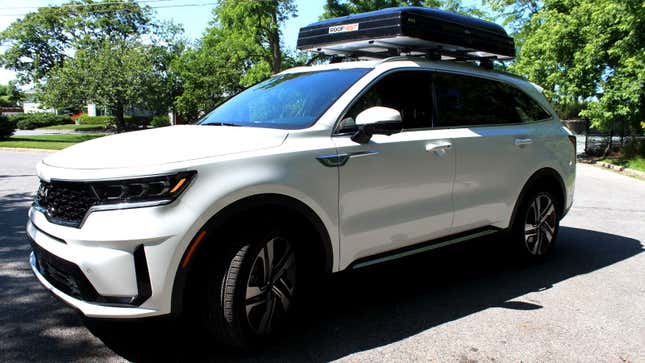When I first sat behind the wheel of the new Kia Sorento plug-in hybrid, it felt enormous. It was easily the biggest car I’ve driven, and I felt pretty daunted to hit the crowded streets of New York City in it. It was taller than I like, the driving position was way higher than I’m used to and the whole car felt a lot longer than anything I’ve driven in the past. All that meant that, initially, I was ready to lament it as being far too big for any normal person’s daily needs.
But after spending four days driving it around Minewaska State park in New York, the Sorento began to grow on me. And, once I’d learned the quirks of its hybrid system, played with all the features, and put it through its paces on mountain roads and city streets, I think I might be coming around to the big car way of thinking.
Full Disclosure: Kia lent me a gleaming white Sorento PHEV with a full tank of gas and plenty of charge in the battery pack for a trip to the mountains.
Editor’s Note: Owen is from England, hence his adorable impression that the firmly midsize Sorento is somehow “huge.” Next I’m going to put him in an Escalade. -Bob

What Is It?
The Kia Sorento PHEV is, as you might expect, a plug-in hybrid version of Kia’s wildly popular Sorento SUV. From the outside, it looks identical to the standard car, save for a charging port on the rear passenger side and a small badge on the liftgate explaining that it’s a hybrid.
From a looks perspective, it’s good that the plug-in is similar to the standard car — this is a pretty good-looking SUV. Sure, it’s big and bulky, but the soft curve of the roof and angular back end look nice.
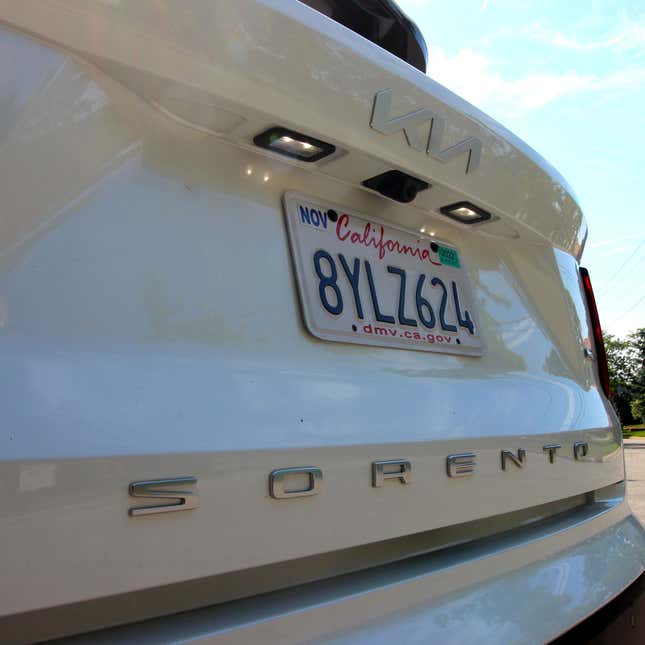
It’s at the front, though, where Kia’s designers have done their best work – especially in this snow white pearl color worn by my review model. This color makes the dark, glossy grille really pop, with the daytime running lights making for a sharp front end.
Under the hood is the real talking point, though: Kia’s latest hybrid power unit. In the Sorento, this powerplant takes the form of a turbocharged 1.6-liter four-cylinder engine paired with an electric motor. Between them, the two produce 261 HP to haul around this 4,500-lb SUV.
And for what this car is designed to do, that feels like plenty. The throttle was quick to respond whenever I needed an extra burst of momentum, and it could haul itself up hills and mountain passes with ease – even when loaded up with camping kit. But the system didn’t come without quirks.
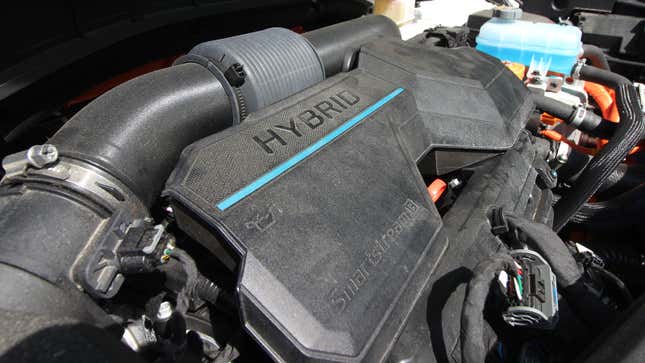
What Makes the Hybrid System so Quirky?
Firstly, I found it strange that the car was so keen to jump out of its all-electric mode. You can set the Sorento to run on battery power alone, or select Auto, Sport or Snow mode. When it’s set to Auto, it’ll only operate on pure battery power if you’re committed to steady-state cruising. If you ask for even a whiff of acceleration, the gasoline engine kicks in.
This meant that sometimes the electric range estimate on the dash would stay level through miles and miles of driving, while other times the charge would plummet as the car favored electricity over dinosaur fuel. This usually happened when I was running at lower speeds or navigating traffic. There, the battery pack does its work rather nicely and you can watch with joy as your average MPG for your trip rises and rises as you tootle along without using a drop of fuel. Once you speed up, though, the engine kicks in and the battery takes second fiddle.
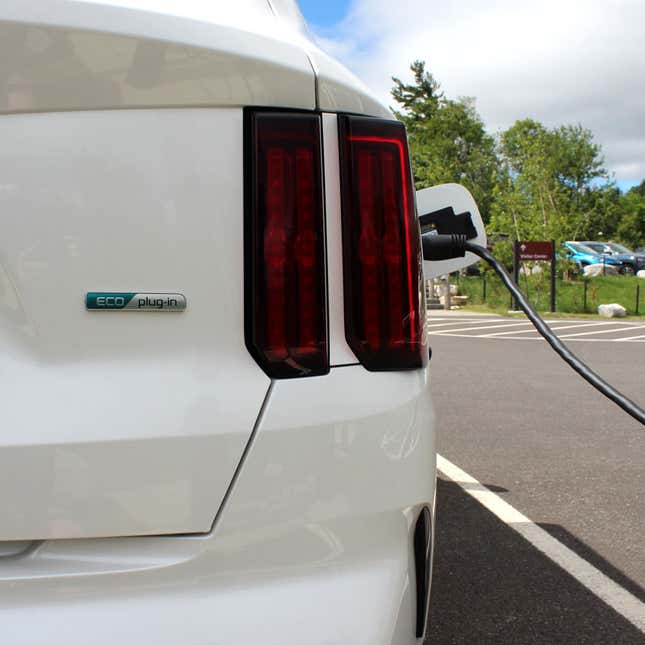
Once the charge level drops, refilling the battery isn’t quick. The Sorento PHEV can’t manage the super-fast charging times you might see in a Tesla or Kia’s own EV6. It’s instead limited to Level 2 charging, which tops up your battery at a much slower rate.
As such, a four-hour pit stop at a national park with a slower charger gave me a full battery and plenty of time to head out and enjoy the hills. A full battery, Kia says, is enough to give you 32 miles of all-electric range.
Once you’re fully charged, the hybrid system does a phenomenal job of extending your gas mileage. I was able to notch up around 44 mpg while driving this SUV around town, hitting the high 30s on the highway. So, while I’d like a little more control over when to favor battery power over gasoline, it was nice not having to worry about filling the tank too often.
There is a cost to this added fuel efficiency, though. This SX-Prestige model I tested carried a base price of $47,800 (a few options brought the sticker up to $49,720 as tested). For comparison, an SX-Prestige non-hybrid model starts at $41,120.
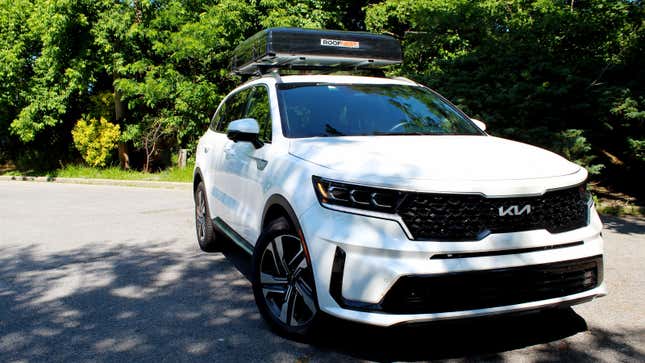
How Does it Drive?
In a sentence, really rather nicely.
Thanks to that battery power, the Sorento PHEV is quick off the line, albeit with a slight jolt when the engine takes over. It’s not like the shake of a poorly-timed shift. Instead, it’s more of a little buzz that lets you know you’re now running on gas. The Sorento uses a six-speed automatic, and while the gear changes aren’t seamless, they’re relatively smooth. You also have the option to cycle through the gears via paddles on either side of the wheel, which were good to have on the twisty mountain roads I encountered. Sometimes it felt like the engine needed a bit of encouragement when heading uphill — a quick downshift soon sorted this.
And while we’re on the subject, I wasn’t in love with the shift dial, which toggles between Reverse, Neutral and Drive, with a separate button for Park. Sometimes it felt like I’d twisted it enough to change gears, without any luck. Some haptic feedback here would be nice.
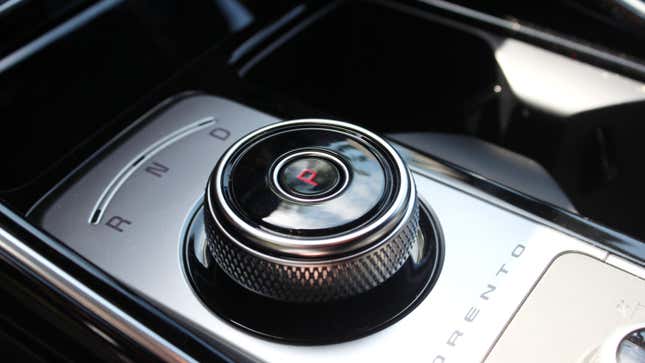
These little gearbox niggles were the car’s only minor downsides. The steering was appropriately light, responsive to even the smallest of adjustments. And, despite the car’s heft, and the added weight of the roof-top pop-up tent we hauled around for our weekend, the brakes were firm and confident without being overly sharp.
The extra weight on the roof was also easily absorbed by the Sorento’s suspension, which made for a delightfully comfortable ride on the highway. When tackling switchbacks and mountain passes there was a little more movement in the cabin than my slightly carsick companion would have liked. The term “bilious” was batted around when describing the drive to camp.
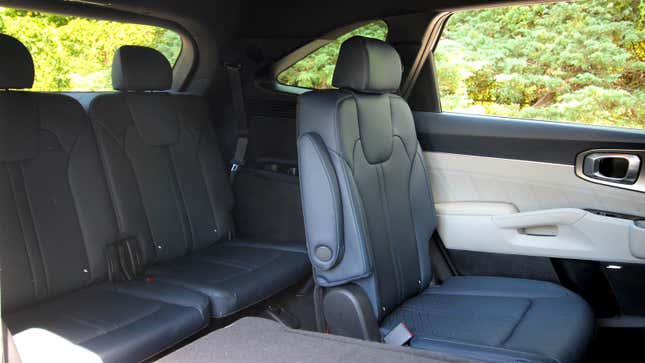
What’s Inside the Sorento PHEV?
Let’s start with the really mind-blowing feature: vented seats. Sure, this is an option on loads of cars these days, but here in the Kia I absolutely loved it. The super-padded leather drivers seat was great at cushioning me while we drove around. And any worries about getting overheated in the summer sun were quickly quashed by those delightful vents. A quick flick of a switch and BAM! Balance was restored.
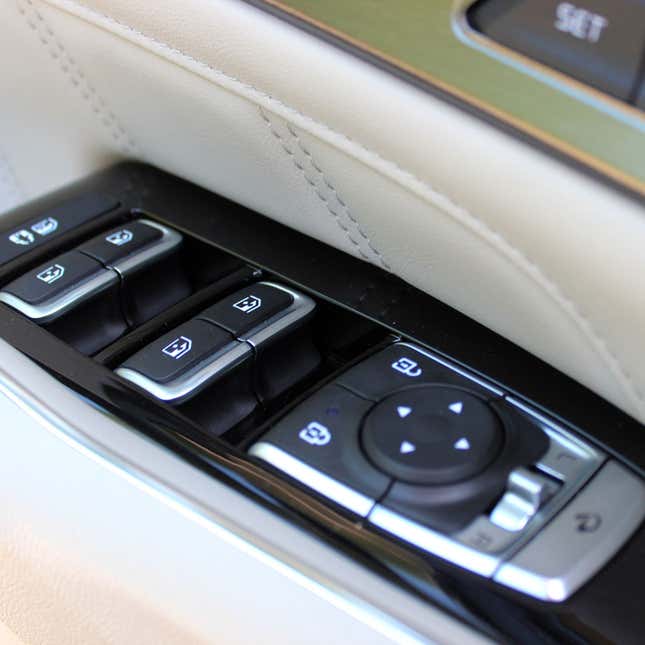
There was a moment where we were driving around, A/C blasting to keep our fronts cool, vented seats on to keep our backs comfy and the car’s heated steering wheel warming my poorly-circulated fingers. I’ve seen true luxury, and I want in.
Elsewhere, though, the cabin was just as excellent.
The Sorento is a proper three-row, and our review unit had captain’s chairs in the second row with enough legroom to fit almost anyone comfortably. Behind this was a third row that could be folded flat to create a gaping chasm of a trunk. Four days’ worth of camping supplies and food was easily housed back there.
Everything in our loaner was finished in navy and cream leather, paired with warm aluminum details on the doors and dash. A hatched pattern covered these metallic accents, and that looked pretty sleek. It was all put together beautifully and had a really premium feel across the board.
And when you come to interact with the car, it’s a similarly excellent affair. The steering wheel has a great feel to it, and there are proper tactile buttons on hand for the features and functions you’re most likely to use while driving.

This is also the case with the center console, which has satisfying switches for some functions and a few less tactile controls for things like the AC and temperature settings.
Other than this, most of the car’s features are handled through the infotainment system, which is based around a 12.3-inch touchscreen.
On the whole, this was super simple to use and paired with both Apple CarPlay and Android Auto easily. It did lack a little bit in the navigation department, struggling to locate a few Walmart stores when we searched and not recognizing the location of our campsite. But thankfully, a quick scroll on the map let us locate the spot and start the directions.
Also, quick shoutout to the connectivity in the Sorento. In the front, we had three USB ports and a Qi wireless charging pad. There were a further two USB sockets in the middle row and two more in the back. It would be nice if one of these was USB-C, but so far the Sorento PHEV has more USB plugs than I have devices that need charging.

How Did the Sorento PHEV Change My Mind on Big Cars?
Sure, the navigation could be better, and any shortcomings in the gearbox programming can quickly be overcome with the flick of a paddle, but those quibbles aside, I really did enjoy my time with the Sorento PHEV. And that came as a surprise to me — when I first climbed behind the wheel I was fully prepared to stress about the Sorento’s gargantuan dimensions for four days.
But as I drove it up mountain passes and through city streets, the Sorento slowly began to make perfect sense. At times it might lumber around tight corners, but it keeps you comfortable and you feel safely planted through all sorts of driving. Then, when you’ve enjoyed your time off the beaten path and are ready to head back to civilization, the Sorento really comes into its own.
I’ve spent years thinking cars like this are just too big and unnecessary. But while stuck in a two-hour traffic jam from Long Island back into Manhattan I began to get it.
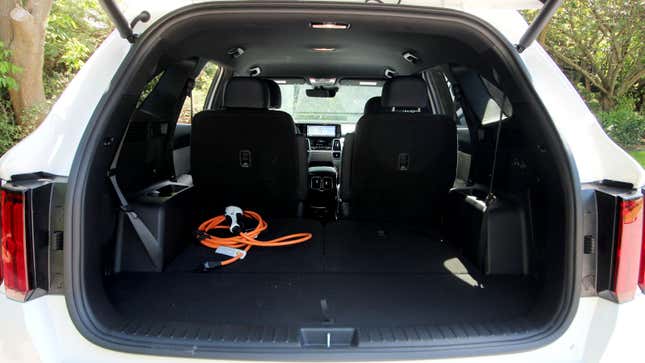
When you’re commuting like this, the creature comforts you can fit into a car this size are lovely. That extra padding on the driver’s seat — wonderful. The cool breeze from the seatback — delightful. The extra leg room you have in a bigger car like this? A welcome relief.
And I finally understand the extra confidence and security that comes with a raised driving position. Top all that off with an eye-catching design like the Kia has and I’m beginning to get why America likes big cars such as this one.
And, when 44 MPG is achievable, and less than $75 worth of fuel can keep you adventuring upstate for a long weekend, why would you possibly consider a car of this size that isn’t a hybrid? If you’re sensible enough to make that call, the Sorento PHEV will suit you down to a T.
